Kore.ai is well known in conversational AI, helping companies handle routine queries, improve efficiency, and deliver steady customer support. Still, many organizations are starting to consider Kore.ai alternatives that cater to more demanding requirements.
Performance results are just as important. Leaders are pressured to achieve faster resolutions, improve self-service, and raise satisfaction scores. While Kore.ai remains a reliable choice, it does not always meet every budget, integration need, or industry-specific demand.
For example, some G2 users found that internal server errors were reported when deleting bots, which can disrupt workflow. The platform also lacks a cloning option for digital forms, making it slower to create multiple versions. And if you’re not very technical, setup and customization can feel tricky.
Plus, companies want tools that work smoothly with existing systems like CRM, telephony, and knowledge bases. They are also asking for clear pricing models, stronger data security, and governance features they can trust.
In this blog, we’ll look at nine leading Kore.ai alternatives, outlining their strengths and why they are worth considering for customer service in 2025.
TL;DR – Best Kore.ai Alternatives in 2025
- Best All-in-One CX Platform: Kapture CX
- Best for Voice-First Automation: Cognigy
- Best for SMBs & Ease of Use: Freshworks (Freddy AI)
- Best for Enterprise Messaging: LivePerson
- Best for Sales-Led Conversations: Drift
- Best for Self-Service Automation: Ada
- Best for Developers & Customization: Botpress
- Best for Regulated Voice & Analytics: Uniphore
- Best for Mature Ticketing + AI: Zendesk
What Factors to Look for in Strong Kore.ai Alternatives
Grand View Research notes that the conversational AI market was about $11.576 billion in 2024 and could reach $41.393 billion by 2030. The size of this growth shows why customer experience teams are reviewing their platform choices carefully.
To make a sound decision, businesses need to check how each option performs in practice, how simple it is for teams to use, and whether it can scale as service demands increase. These evaluation points make it easier for you to choose from the strongest Kore.ai alternatives available today.
1. Voice and Chat Support
Some platforms are designed primarily for voice, while others emphasize chat or offer a comprehensive omnichannel model. The strongest alternatives enable customers to move from phone to live chat or social messaging without losing context.
Providing this continuity is essential, since consistent experiences across channels have a direct impact on loyalty. Research from CapitalOne Shopping shows that businesses with omnichannel engagement retain 90% more customers than those relying on only one channel. Competing solutions from Kore.ai competitors often emphasize this capability to strengthen retention.
2. Latency and Response Times
Even short delays can affect the quality of an interaction. For voice, anything above half a second makes a conversation feel less natural. Reliable providers share clear performance data under real-world conditions. These reports show how the platform holds up under pressure and whether it delivers steady results.
In chat and messaging, speed is equally important. Customers often expect near-instant responses, and delays can cause frustration or prompt them to abandon self-service options. Platforms that maintain responsiveness during peak demand make it easier for service teams to meet targets and sustain customer confidence.
3. Ease of Use and Low-Code Builders
Teams in customer service often just want tools they can handle without asking IT for help. No-code or low-code tools allow teams to adjust workflows without developer help.
Some platforms also provide ready templates for FAQs, scheduling, or lead capture to cut setup time. These shortcuts shorten onboarding, helping teams reach full productivity sooner and contribute value without extended training. A quicker onboarding process also minimizes disruption when moving away from legacy systems.
| Did You Know? Forrester found that 71% of business and technology professionals say their companies already offer chatbots, showing just how widespread conversational AI adoption has become. |
4. Flexible Deployment and Telephony Integration
Infrastructure setups are not the same everywhere. One company might lean on cloud tools, another sticks with servers on-site, and plenty use both together.
A platform has to cope with each of those situations; otherwise, it quickly becomes a blocker. It also needs to link into phone systems. BYOC (Bring Your Own Carrier) is what makes that possible for teams that want to keep the lines they already run.
5. Compliance and Security
Many industries expect compliance with GDPR, SOC 2, HIPAA, and ISO 27001. Enterprise platforms usually meet these standards while also applying encryption, access controls, and clear rules for managing data.
Some firms also evaluate Kore.ai Experience Optimization (XO) platform alternatives to ensure compliance features extend beyond the basics.
6. Pricing Transparency
Unclear pricing can make scaling costly. Transparent, tiered models with defined inclusions provide greater predictability and help businesses manage budgets effectively.
7. Support, Documentation, and Community
The quality of support often shapes how quickly a team adjusts to a new system. Providers that deliver responsive help, clear documentation, and an engaged user community give businesses a stronger base to succeed.
Methodology: How We Chose These Kore.ai Alternatives
This list is based on a review of G2 ratings (as of Sept 2025), analyst reports like the Gartner Magic Quadrant, and adoption trends across industries such as BFSI, Retail, Travel, and Healthcare. We compared platforms on ease of use, AI capabilities, omnichannel coverage, deployment flexibility, compliance, and pricing transparency to ensure a fair and practical roundup.
Comparison Table: Kore.ai’s Competitors and Alternatives
A clear comparison makes it easier to evaluate which Kore.ai alternative best fits your CX goals. The table below provides a side-by-side view of Kore.ai and its leading alternatives.
| Tool | Ease of Use | AI Capabilities | Omnichannel Support | Enterprise Readiness | G2 Rating |
| Kore.ai | Visual builder available; advanced functions often need technical support | Conversational AI with NLP, voice and chat automation, analytics | Broad coverage across chat, voice, and digital channels | Scales for large deployments | 4.7/5 |
| Kapture CX | Quick setup with industry-focused templates | AI chatbots, voice automation, agent assist, analytics | Omnichannel across voice, chat, email, and social | Enterprise-grade workflows, ticketing, reporting, and compliance features | 4.6/5 |
| Cognigy | Straightforward interface for designing conversation flows | NLP, multilingual bots, AI orchestration | Supports voice, chat, and telephony | Suitable for regulated sectors; cloud, hybrid, and on-premises available | 4.6/5 |
| LivePerson | Easy to use for digital messaging | AI-driven support and sales conversations | Strong in messaging; voice available | Used by global enterprises; meets compliance standards | 4.4/5 |
| Freshworks | Accessible no-code tools | AI for ticket resolution, chat, and workflows | Good chat coverage; voice less advanced | Cloud-based, integrated with Freshworks suite | 4.5/5 |
| Zendesk Support Suite | Simple workflow automation with no-code options | AI for routing, chatbots, and sentiment detection | Email, chat, social; telephony through partners | Mature platform with strong compliance credentials | 4.3/5 |
| Drift | Simple interface for marketing teams | AI for lead capture, qualification, and chatbots | Primarily chat and messaging | Enterprise-ready for sales and marketing functions | 4.4/5 |
| Ada | Non-technical teams can update easily | AI for self-service and intent recognition | Chat, social, email, some voice | Used for customer support and retention in enterprise settings | 4.6/5 |
| Botpress | Visual flow builder; developer-friendly with a learning curve | NLU and LLM support with generative responses; SDKs and APIs for custom logic | Chat and messaging across web and apps; voice available via integrations | Flexible architecture used by SMEs and enterprises | 4.5/5 |
| Uniphore | More complex setup; designed for voice-first workflows | Speech analytics, biometrics, quality monitoring | Strong in voice with chat and messaging support | Focus on regulated industries; cloud and on-premises available | 4.2/5 |
Top 9 Kore.ai Alternatives & Competitors in CX for 2025
There is no single platform that fits every CX strategy. We have curated a list of alternatives that address a range of needs. Some focus on voice automation or deployment flexibility beyond what Kore.ai typically offers.
Others provide deeper industry workflows, native ticketing, or advanced telephony integrations tailored to specific infrastructure needs. The following list highlights nine strong Kore.ai alternatives for 2025.
1. Kapture CX
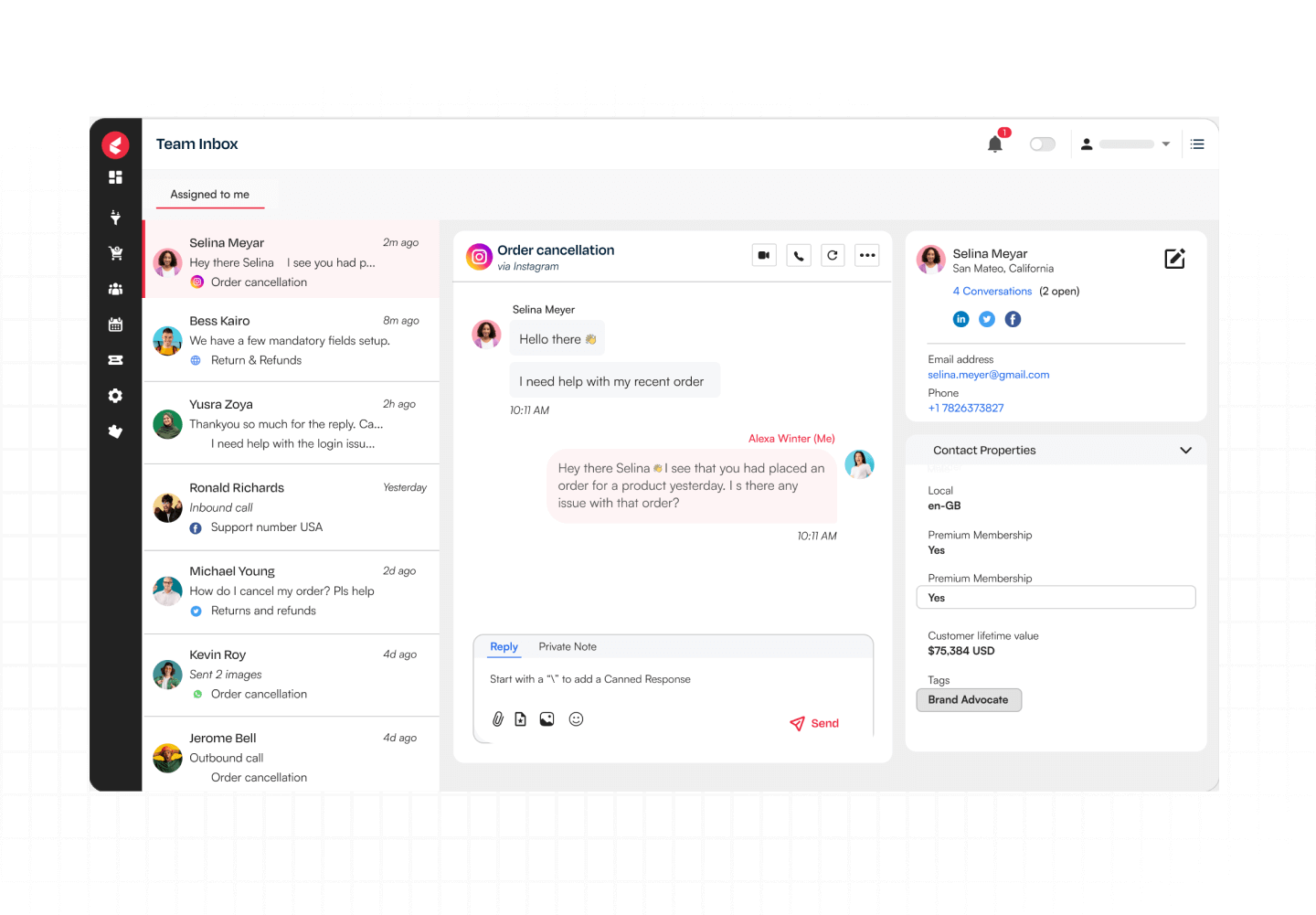
Kapture CX is a unified customer experience platform that combines self-service bots, voice and chat automation, agent assist, and analytics. It helps enterprises automate resolutions while maintaining context across channels.
How It Compares to Kore.ai
Kore.ai focuses on conversational AI. Kapture CX covers more. It adds automation, ticketing, routing, and analytics. That makes it useful for companies that want conversational AI plus full-service operations in one place.
Industries/Use Cases
BFSI, retail, travel, energy, utilities, and consumer durables. Often used for hotline deflection, multilingual bots, and AI help for agents.
G2 Rating: 4.6/5 (300+ reviews)
Strengths
- Combines conversational AI with ticketing and workflows so teams can manage the full cycle of service
- Industry templates help banks, retailers, and others configure their systems and launch more quickly
- Built-in analytics show how the service is performing and where it needs work
Trade-Offs
- Some users have reported slower performance during peak workloads
Ideal for
Enterprises seeking conversational AI with built-in service management tools
2. Cognigy
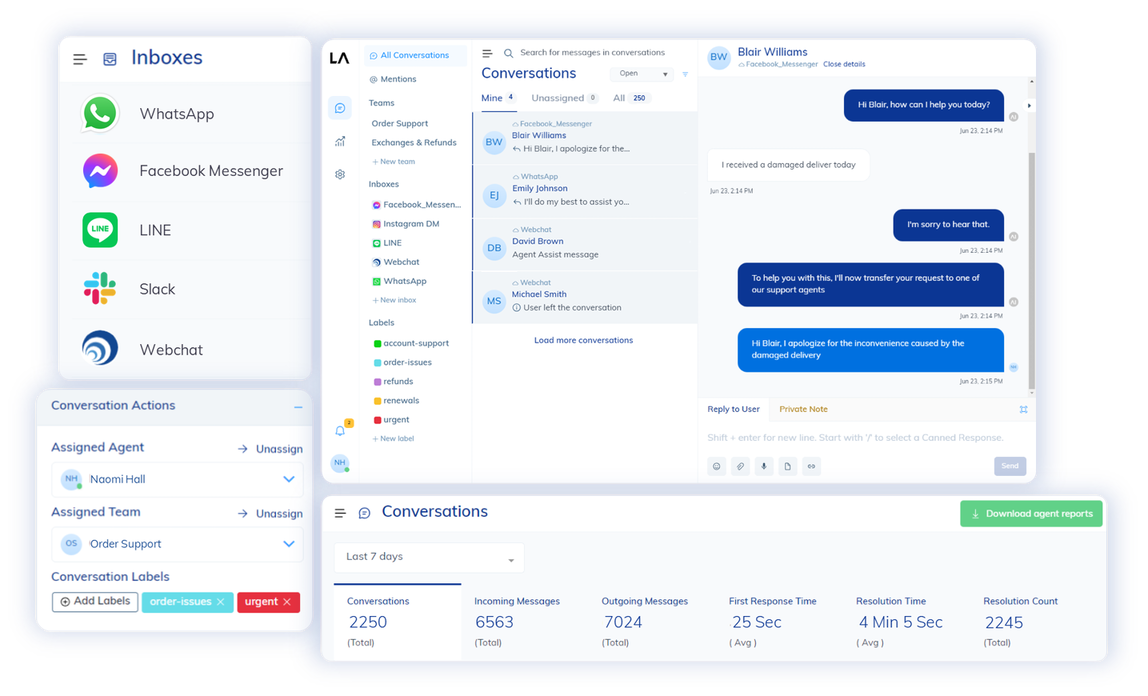
Cognigy is a conversational AI platform that handles large-scale voice and chat automation. It links with CCaaS and CRM systems and has a voice gateway that works with SIP trunks and bring-your-own-carrier setups.
How It Compares to Kore.ai
Kore.ai is strong in conversational AI, while Cognigy’s edge is its telephony integration and flexible deployment. Companies that depend on voice channels or need hybrid and on-premises setups often turn to Cognigy as the stronger option.
Industries/Use Cases
Large organizations and regulated sectors. Commonly applied to voice automation, multilingual self-service, live agent support, and secure transactions.
G2 Rating: 4.6/5 (10+ reviews)
Strengths
- Provides advanced voice automation through its Voice Gateway, which links with existing phone systems
- Offers deployment across cloud, hybrid, and on-premises setups to match varied infrastructure needs
Trade-Offs
- Users mention that more pre-built templates would help speed up rollout
Ideal for
Enterprises that want strong voice automation and flexible deployment choices
3. LivePerson
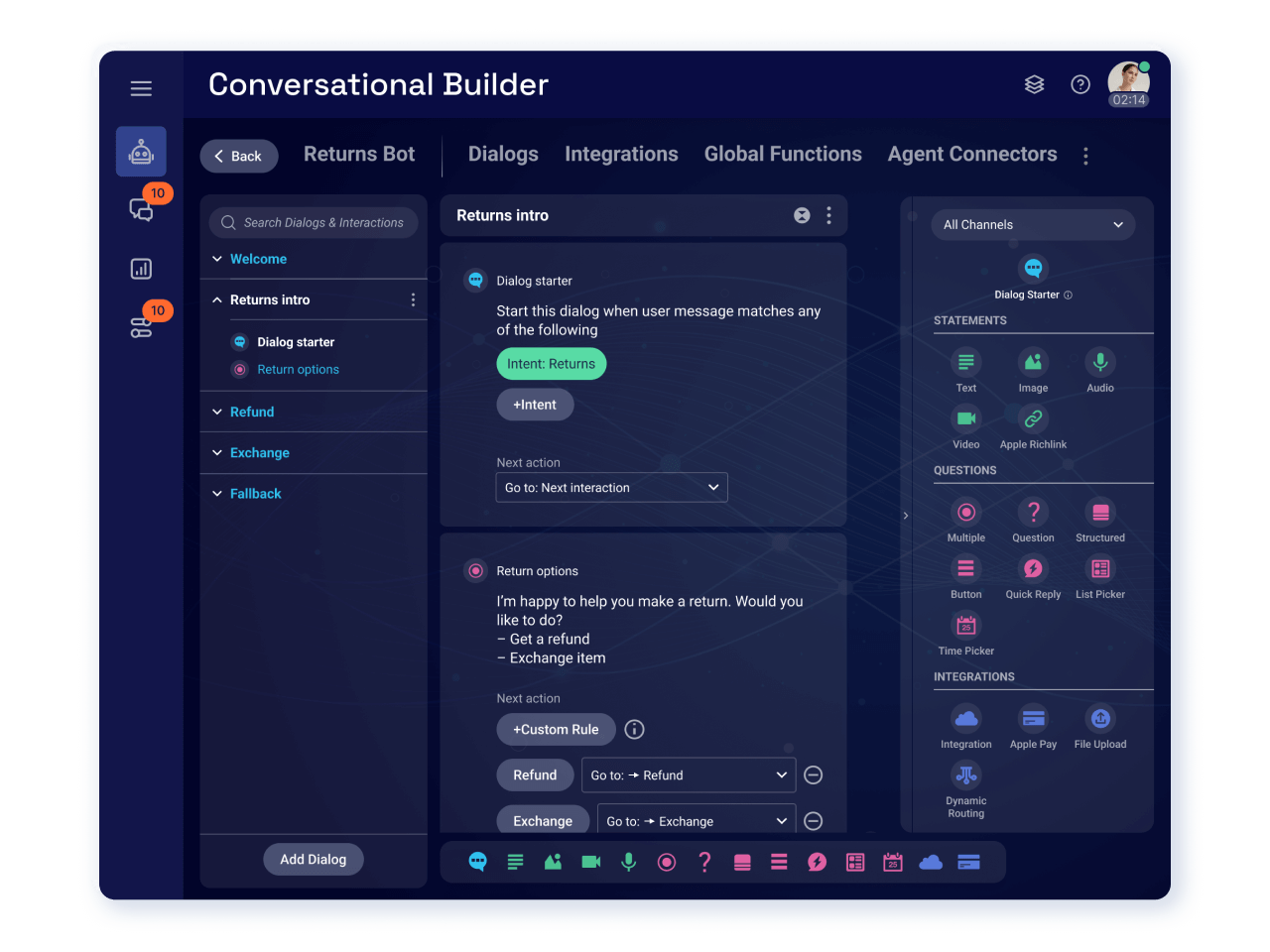
LivePerson is best known for powering conversations across both messaging and voice. It helps create virtual agents that can pick up intent, answer questions, and even guide a purchase.
The best part? Its technology draws on natural language models and conversational design rather than relying on scripted flows.
How It Compares to Kore.ai
Kore.ai delivers strong conversational AI on its own. LivePerson brings in extras such as generative tools, orchestration across channels, and deeper contact-center links. That mix makes it attractive for businesses that need scale and heavy integration with existing systems.
Industries/Use Cases
LivePerson is used in banking, healthcare, retail, telecom, and automotive. Typical tasks include answering FAQs, routing calls with virtual agents, helping customers shop, and giving agents quick summaries.
G2 Rating: 4.4/5 (370+ reviews)
Strengths
- Keeps conversations connected across voice and messaging
- Uses analytics to learn from interactions and improve results
Trade-Offs
- Expanding into voice and multi-channel setups can raise costs
Ideal for
Mid to large firms that need a single platform for both support and sales
4. Freshworks
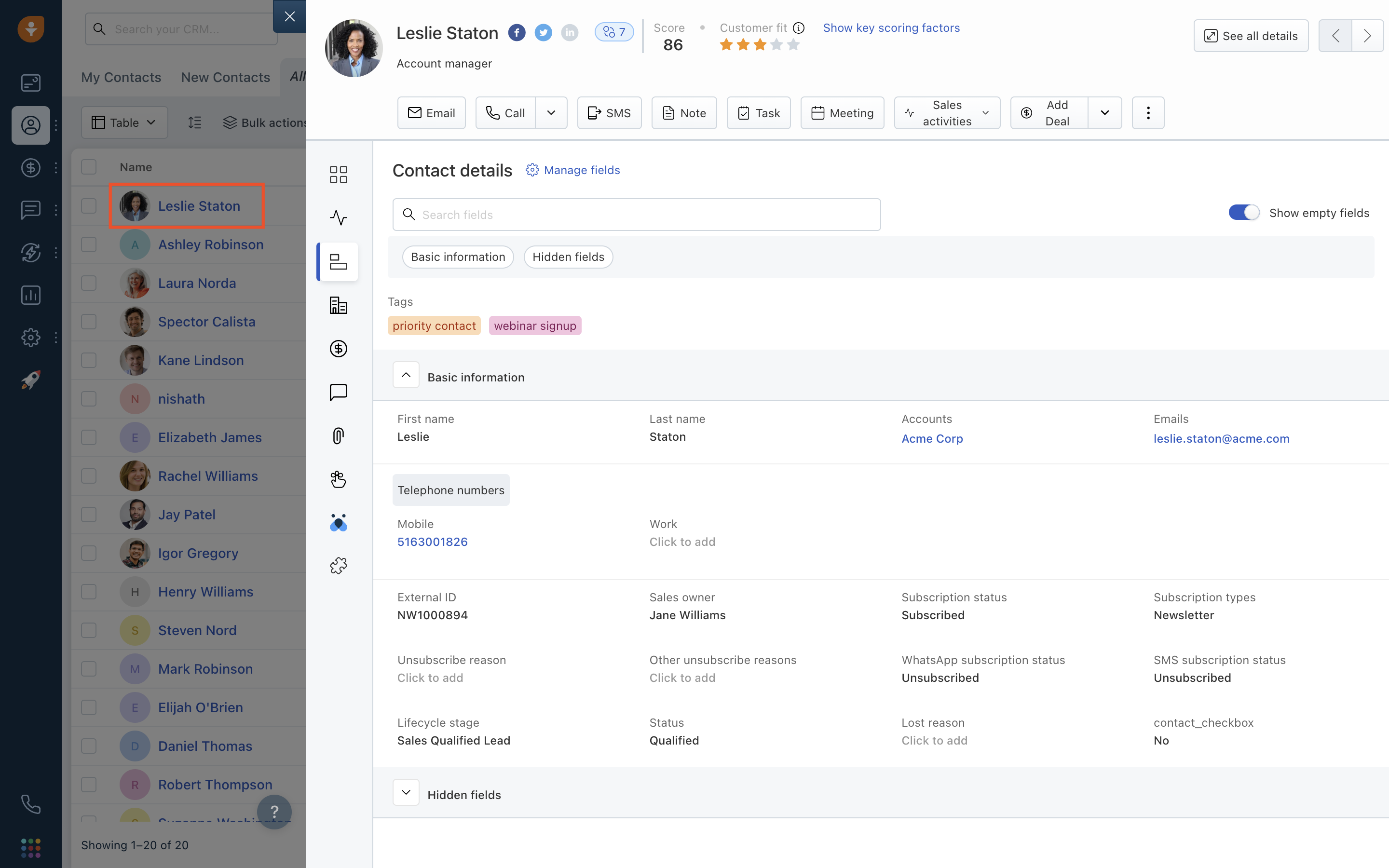
Freshworks brings Freddy AI into its Freshdesk platform. The tools include automated self-service, agent assistance, and conversational bots. Typical tasks it can handle are triage, intent recognition, reply suggestions, and proactive updates.
How It Compares to Kore.ai
Kore.ai is built as a full conversational AI suite. Freddy AI, on the other hand, is designed to make everyday helpdesk work faster. Businesses already on Freshworks can add AI without learning an entirely new system.
Industries/Use Cases
Freddy AI is popular with small and mid-sized businesses. Larger support groups in retail, e-commerce, SaaS, and consumer goods make use of it as well. Teams use it to speed up ticket resolution. They also use it to suggest responses for agents or to run basic chatbots that handle routine questions.
G2 Rating: 4.5/5 (8,000+ reviews)
Strengths
- Reduces manual effort through summaries and reply suggestions
- Provides a builder that staff without coding skills can use
Trade-Offs
- Expanding beyond the Freshworks ecosystem may require outside integrations
Ideal For
Teams already using Freshworks that want to add AI features step by step
5. Zendesk Support Suite
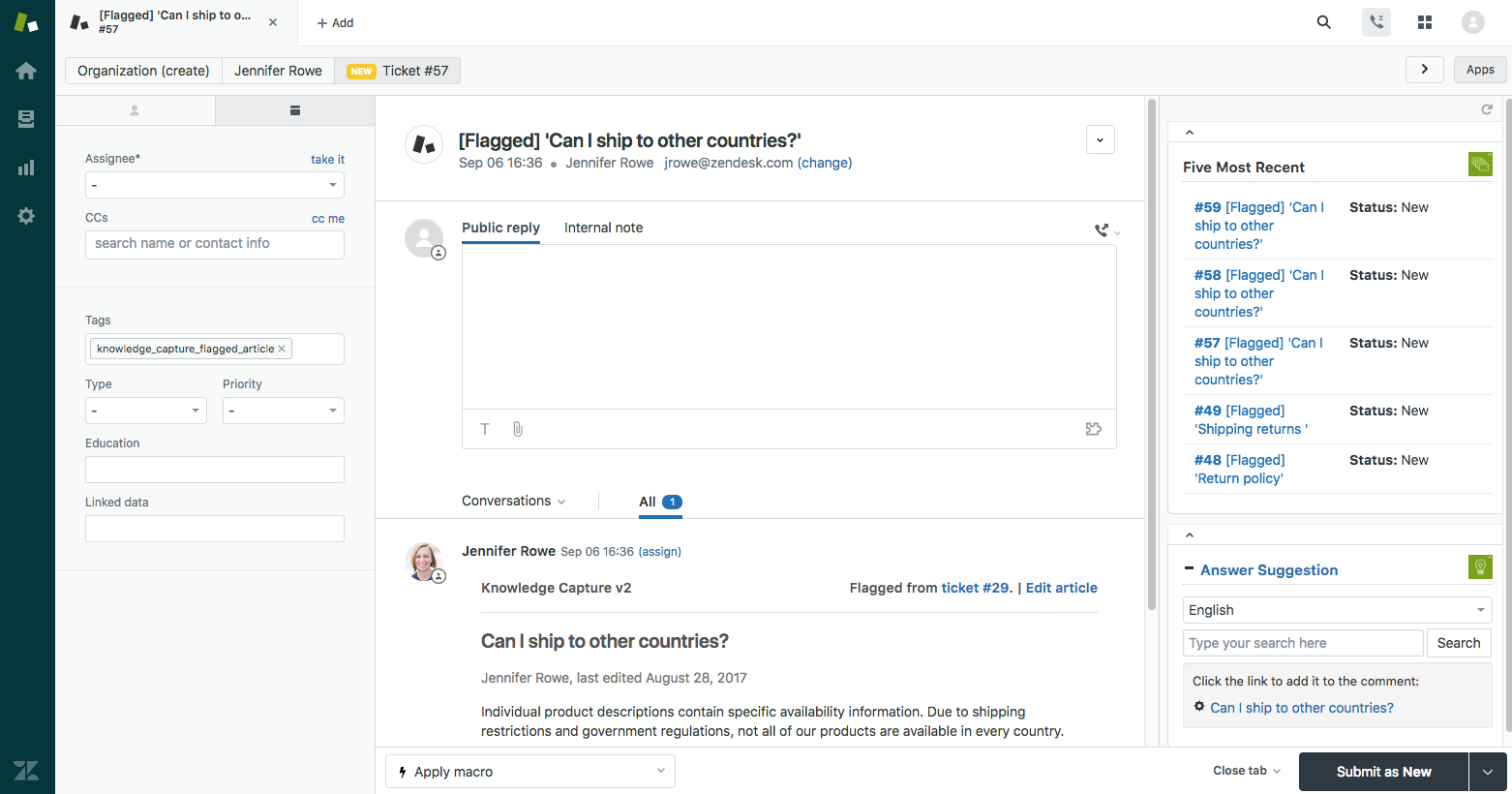
Zendesk Support Suite is a widely used customer service platform that combines ticketing, multi-channel support, and AI-driven assistance within its workflows.
How It Compares to Kore.ai
Kore.ai is widely linked with virtual assistants and conversational automation, but Zendesk takes a simpler approach. Its focus is ticketing first, with AI added into the workflows agents already use. For many organizations, this feels easier than starting with custom bot development.
Industries/Use Cases
Zendesk is used by small teams and global enterprises alike. It helps manage heavy volumes of email and chat. Many deploy it to automate repeated responses or to send tickets to the right queue based on tone or intent.
G2 Rating: 4.3/5 (6,650+ reviews)
Strengths
- AI is built directly into the ticketing system, helping agents close issues more quickly
- Multiple channels are supported while keeping the customer context connected
Trade-Offs
- The AI layer is lighter compared with platforms built purely for conversational bots
Ideal For
Support teams that rely on ticketing and want to improve speed with AI, without moving to a full conversational AI platform
6. Drift
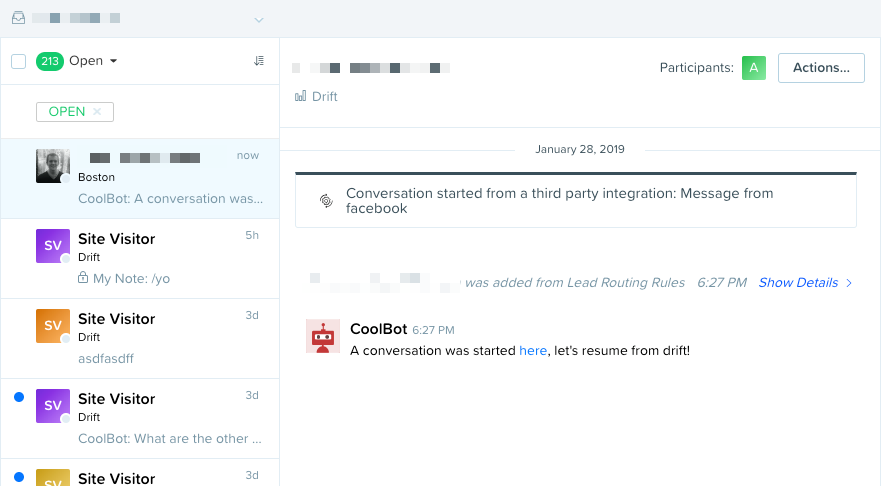
Drift helps companies capture interest early in the buyer journey. It uses chat agents to engage site visitors, assess whether they are potential leads, guide them toward sales teams, and record the exchange in systems like HubSpot or Salesforce.
How It Compares to Kore.ai
Kore.ai tends to deliver more comprehensive conversational agent capabilities across customer support, whereas Drift emphasizes sales and marketing engagement.
It delivers more immediately relevant tools for teams whose priority is lead conversion and website-visitor interaction. This makes Drift one of the more practical alternatives to Kore for organizations focused on lead conversion and website engagement.
Industries/Use Cases
Most often it’s used in B2B SaaS and enterprise sales, but you’ll also see it applied in e-commerce, customer success, and marketing. Common uses include checking the quality of leads and arranging meetings.
Many companies also use it to adapt their sites for visitors and to keep follow-up activity running without extra effort.
G2 Rating: 4.4/5 (1,200+ reviews)
Strengths
- Helps sales teams by connecting with visitors immediately and passing qualified leads straight to them
- Integration with major CRMs and marketing tools helps maintain consistency across marketing, sales, and support efforts
Trade-Offs
- Because its focus is sales and marketing, Drift’s support-oriented features, like ticketing or helpdesk workflows, are less developed
Ideal For
Organizations whose main goal is to generate and qualify leads quickly and improve sales conversations
7. Ada
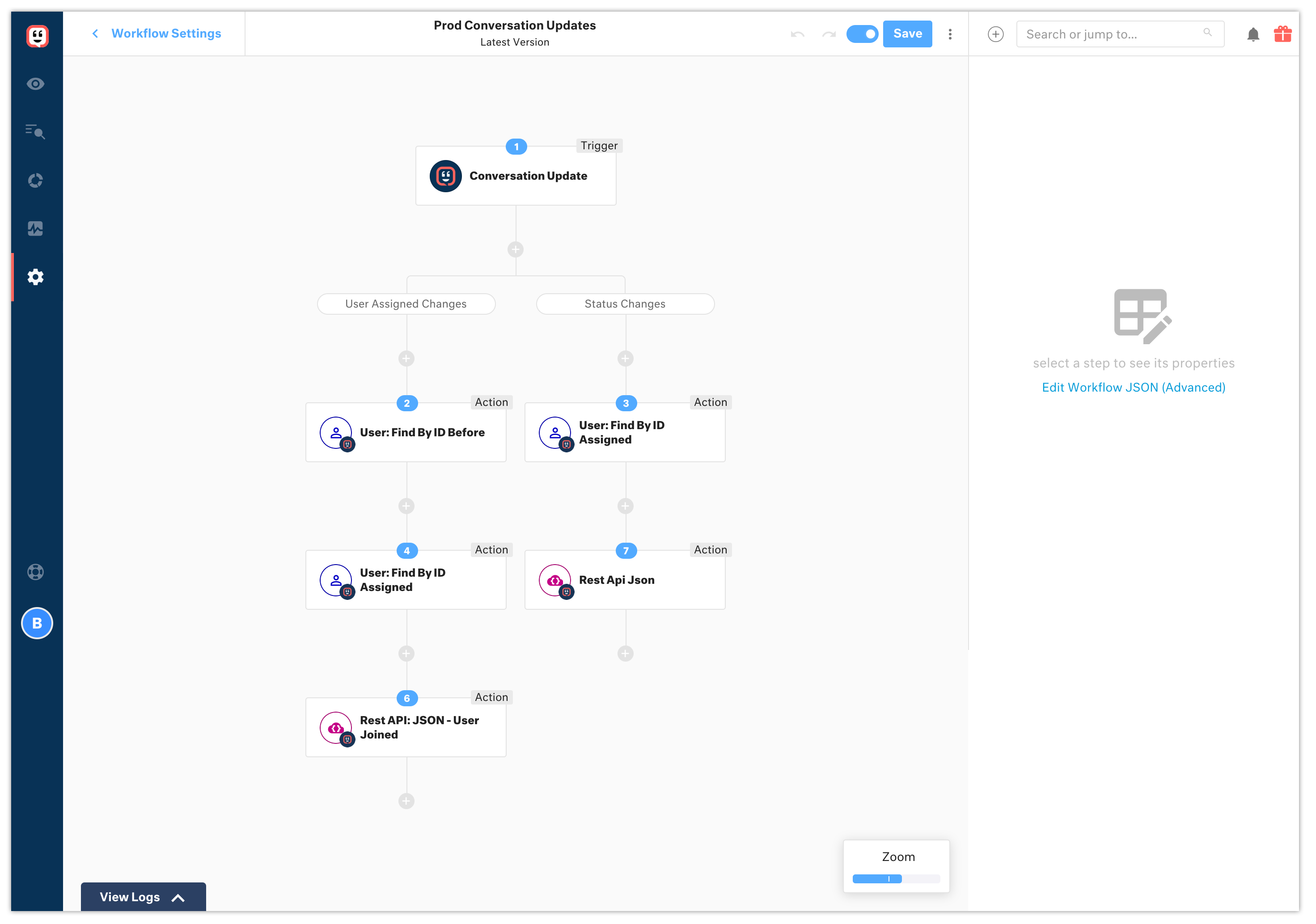
Ada is built to manage customer requests through chat, voice, email, and social. It offers automated resolution, a simple editor, and dashboards for tracking agent results.
How It Compares to Kore.ai
Kore.ai is strong in conversational workflows and agent assist, but Ada focuses on reducing manual effort. It automates repetitive queries and gives business teams the tools to update the platform without coding.
Industries/Use Cases
Ada is active across industries such as retail, insurance, banking, digital services, and technology. It is used for self-service bots, multilingual service, reducing routine workload, and achieving faster resolutions.
G2 Rating: 4.6/5 (150+ reviews)
Strengths
- Automates routine inquiries to free staff capacity
- Provides non-technical users with editing tools for fast updates
Trade-Offs
- Voice channel features are not as advanced as text-based ones
Ideal For
Businesses that want to scale self-service while keeping updates in the hands of operations teams rather than developers
8. Botpress

With Botpress, teams get an open-source framework that allows them to shape bots the way they want. Developers can move past templates, build custom logic, and tie the bots into their existing tools.
How It Compares to Kore.ai
Kore.ai comes with a large enterprise package designed for out-of-the-box use. Botpress is different: it gives more room for customization. Many teams choose it when they need to fine-tune conversations or handle back-end integrations that require extra control.
Industries/Use Cases
Common in tech firms, startups, and education settings. Projects often involve multilingual bots, custom helpdesk workflows, or assistants embedded in apps and websites.
G2 Rating: 4.5/5 (400+ reviews)
Strengths
- High level of customization for conversation design and workflows
- Includes visual design tools that simplify building while still allowing coding when required
Trade-Offs
- Initial setup can require more developer input compared to platforms that emphasize pre-built templates
Ideal For
Organizations that want strong developer control, highly customized conversational experiences, and multilingual support with flexible integrations
9. Uniphore

Uniphore is a conversational AI company that specializes in voice automation, speech analytics, and real-time customer engagement. Its platform supports large volumes of voice interactions.
How It Compares to Kore.ai
Kore.ai offers strong capabilities in chatbots and text-based automation. Uniphore, by contrast, is tailored for voice, with advanced speech recognition and analytics that give it an edge for spoken interactions.
Industries/Use Cases
Uniphore is widely used in banking, telecommunications, healthcare, and utilities. Teams use it to cut down repetitive tasks, validate customers by voice, support agents as they talk, and audit calls for compliance needs.
G2 Rating: 4.2/5 (40+ reviews)
Strengths
- Offers deep voice automation, including analytics and biometric checks that help with security rules
- Handles very high call volumes, making it reliable for enterprises that run large-scale operations
Trade-Offs
- Setup is not always simple, and connecting with existing systems can raise costs
Ideal For
Enterprises that depend on voice as their main service channel and need strong compliance and speech analysis built in
How Kore.ai Measures Up: Strengths & Weaknesses in CX Context
Kore.ai enables omnichannel deployment, integrates well with enterprise systems, and supports multiple languages. Its design studio and ready-made templates are especially valuable for organizations that want to accelerate bot development.
Key strengths include –
- Easy deployment across channels such as chat, voice, and digital interfaces
- A visual design studio and templates that simplify bot building
- Analytics and reporting that provide insights into performance and customer satisfaction
- Multilingual capabilities that support global service needs
Despite these advantages, Kore.ai has limitations that are important to consider. Performance can be inconsistent in complex workflows, and advanced configuration often requires technical expertise.
Some reported weaknesses include –
- Occasional lag or glitches when managing large or complex flows
- A steep learning curve for non-technical users handling advanced features
- Pricing that lacks transparency and increases as usage expands
- Documentation and support responsiveness that some users find insufficient
Why Retention & CX Leaders Should Consider Switching
CX leaders should regularly reassess whether current platforms meet expectations. Reasons to explore Kore.ai alternatives include –
- Performance Concerns – Reliability issues or delays in responses can reduce customer satisfaction.
- Cost Pressures – Scaling advanced features or voice channels may result in higher-than-expected expenses.
- Ease of Use – Platforms with stronger no-code capabilities can reduce dependence on technical teams.
- Customer Expectations – Clients expect consistent, fast, and seamless service across every channel.
- Innovation – Competitors often introduce new features such as multimodal AI, improved analytics, or vertical-specific solutions.
Picking the Right Kore.ai Alternative for Your CX Strategy
Choosing the right alternative to Kore.ai depends on aligning the vendor’s strengths with your CX priorities. Some teams focus heavily on voice automation and quick response times. Others are more concerned with getting a platform running quickly or making sure it works with the tools they already use.
Scaling as demand grows is another factor, along with training staff, handling upkeep, and making sure the system can keep pace over the long term.
Kapture CX suits enterprises that need conversational AI inside a broader CX setup. It includes ticketing, reporting, and industry-specific workflows. Plus, its templates and analytics help teams adopt it quickly and track performance.
To see how it can fit your CX strategy, consider booking a personalized demo and explore how it can improve efficiency and customer experience.
FAQs
Evaluation should include voice and chat performance, plus the speed and reliability of responses. Usability is equally important, with no-code or low-code design tools often making a significant difference.
Transitioning to a new platform may involve migrating conversational flows, updating integrations, retraining staff, and ensuring data pipelines align with the new system. Strong alternatives often provide migration assistance, onboarding support, and partner networks to reduce disruption.
The most effective approach is to begin with pilot projects that use real customer scenarios. Teams should then measure latency and performance under expected workloads, comparing the results with Kore.ai competitors & alternatives to guide their decision.













